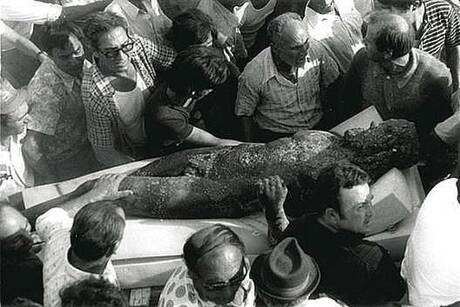He represented one of the central figures, even if almost forgotten, in the story that marked a turning point in the history and heritage of Hellenistic archeology in Calabria and beyond:
the discovery and recovery of the Riace Bronzes.
Giuseppe Foti, at the time regional archaeological superintendent , would have turned one hundred years old, in the year in which the fiftieth anniversary of that extraordinary event that took place on
August 16, 1972 in the beach of Riace Marina, on the Ionian coast of Reggio, is celebrated.
To add a further piece to the mosaic of the stories of those extraordinary days is the testimony of the son of superintendent Foti, Alessandro, at the time in his twenties, and who lived through those excited and exciting phases together with his parent.
Calabria, the 50th anniversary of the discovery of the Riace bronzes
"My father was a 100% Calabrian - says Alessandro Foti - and in that August of '72, returning from a family trip by ship along the Black Sea, I still remember my father's eyes lit with happiness mixed with amazement and wonder in front of the photos of the two statues that would give new life to the Reggio Calabria museum. During that trip between Odessa and the Crimea, whenever possible, dad had been in telephone contact with the recovery operators but seeing those images did not he had managed to hold back the strong emotion ".
Giuseppe Foti had returned to Calabria, first working at Villa Giulia in Rome, in December 1960 as director of the National Archaeological Museum of Reggio and then he had been appointed Archaeological Superintendent for Calabria.
Memories that resurface half a century later.
Not just a fact, the
discovery made 200 meters from the beach and at a depth of 8 meters, by the Roman diver Stefano Mariottini who, during a dive, had seen the two statues partially covered by sand.
The works, probably dating back to the mid-fifth century.
BC and respectively 1.98 and 1.97 meters high, certainly built in Argos in the Peloponnese as it was later ascertained by the analysis of the fusion soils, once recovered, they were in an excellent state of conservation.
"He recognized the two statues as creations of Greek bronzes to be ascribed to the great artistic tradition of the fifth century BC - adds Alessandro Foti - and after the first intervention for desalination in the Calabrian Superintendency, for the restoration he chose the laboratory of the Archaeological Superintendency of Tuscany . So in 1975 the warriors were transported to Florence where there were equipment and personnel with experience in the field of conservation of metal finds of archaeological origin ".
50 YEARS OF RIACE'S BRONZES, 'MY FATHER'S EMOTION'
The restoration activities were complex, lasted eight long years, and ended with a first exhibition in Florence (December 1980-January 1981) and then in Rome at the Quirinale (June-July 1981).
At that point the "Bronzes" phenomenon broke out.
"What I have very much alive in my memory - continues Foti - is the commitment and determination that my father lavished on the return of the two statues to Calabria where they finally arrived to never leave".
A veil of regret shines through in Foti's words.
"Before the renovation of the Reggio Museum - he says - there was an underwater archeology room dedicated to my father, after the works it was canceled. Now there is not even a plate. I can only hope that Calabria, its Calabria don't forget a figure you can and must be proud of ".

